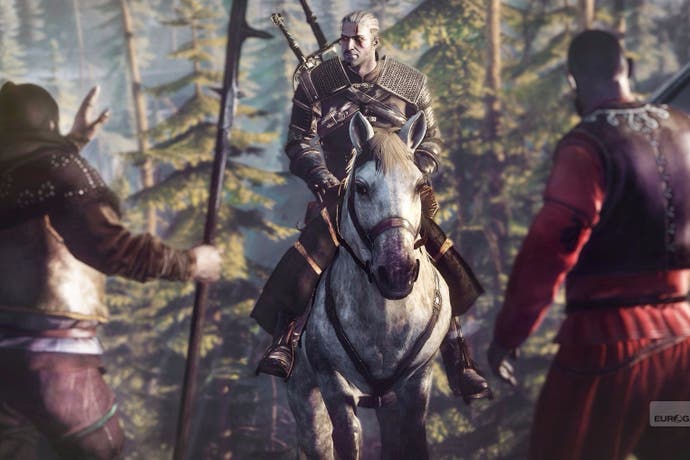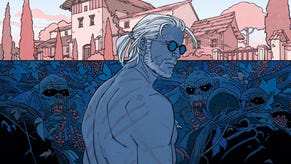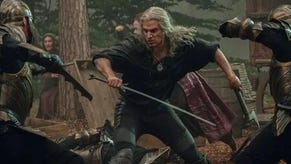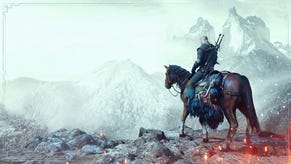The making of The Witcher 3's greatest villain
Dimm view.
Near the start of The Witcher 3, our hero Geralt enters White Orchard Inn searching for his lost lover, Yennefer of Vengerberg. Here he meets Gaunter O'Dimm for the first time - a seemingly ordinary tavern patron who introduces himself as a "mangy vagrant". Previously a mirror merchant, he claims the common folk dubbed him Master Mirror, or the Man of Glass.
O'Dimm blends in: with his everyman face, plain clothes and bald head, he could be any other NPC. Perhaps even one you'll save on the road later. You'd never guess you'd just met Geralt of Rivia's most dangerous foe.
Going back to The Witcher 3's prologue armed with this knowledge gives it an eerie edge. O'Dimm can't be cut down with a silver sword - he could stop time and kill Geralt with a kitchen utensil before our hero had armed himself - yet there he sits, a friendly merchant who's offering to help our hero at no cost. Of course, nothing comes without a price. Master Mirror is pulling Geralt's strings before he even steps foot into war-torn Velen, but he doesn't show his face again until the game's first expansion, Hearts of Stone. CD Projekt knows how to do foreshadowing.
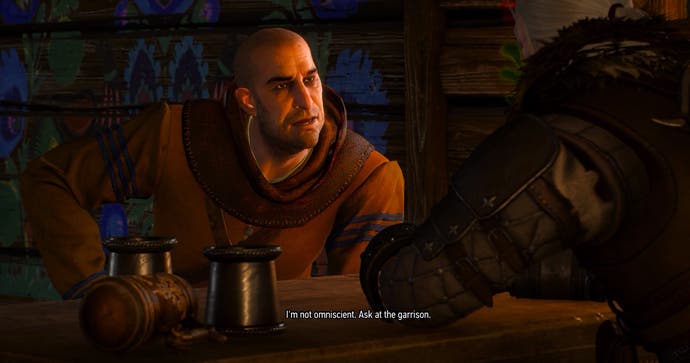
"He was fishing and Geralt swallowed the hook, line and sinker, along with half of the fishing rod," Karolina Stachyra, senior writer on The Witcher 3 tells me. "That's why when Geralt is in trouble - when he's being transported to Ofier to be executed - and Master Mirror appears seemingly out of nowhere to save the day, the witcher doesn't think twice. After all, Gaunter seems like a nice guy, right? He helped him once before and he didn't want anything in return, right? Well, this time's going to be different..."
When we next see O'Dimm in Hearts of Stone, he appears from the shadows in the bowels of a prison ship. It's a fittingly ominous backdrop, where O'Dimm stands just out of sight, lurking in the background through the entirety of Hearts of Stone, disguising himself as a wedding guest, a villager, hired muscle. He's always there, and always watching.
If he stepped up to centre stage, you'd probably recognise him, even though his appearance in the main game was fleeting. Perhaps it's the menacing, calculated delivery of his lines - thanks to veteran British actor Alex Norton - but there's something about him that sears itself into the mind.
"We're always trying to think ahead," says Stachyra. "It's extremely hard to know three or four years before releasing a game that a character, and a very specifically written one at that, will play a key role in an expansion that's set to release a couple of months after the main game. But in some cases, like with Master Mirror, it just clicks.
"We needed a character that would give Geralt a clear hint as to the whereabouts of Yennefer. Quickly, we realised that that this couldn't be just an ordinary person, so we thought about creating this mysterious wanderer, who's very observant, and evidently knows much more than he says he does. And that's how Gaunter O'Dimm was born."
O'Dimm was inspired by Leland Gaunt, the main character in the Stephen King's 'Needful Things'. In the book, Gaunt moves to a small town and opens an antiques store that offers magical items to the town's residents, though they can only be purchased by payment in 'favours'. King's Walter O'Dim - aka Randall Flagg - who travels between novels (or dimensions) to perform evil deeds in The Stand shares more than the best part of a name with O'Dimm too.
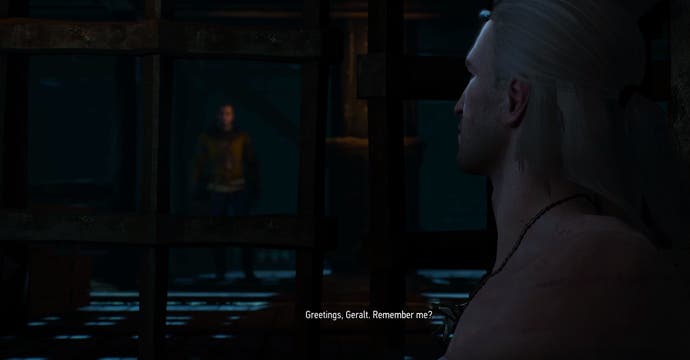
As with so many of The Witcher 3's quests, fairy-tales acted as a muse. "When we were writing the dialogue for the tavern scene in the prologue it became clear that Gaunter is a character with amazing potential," Stachyra explains. "So we started thinking about the best ways we could use him for the story.
"We managed to come up with a couple of cool ideas, and then one day [CD Projekt Managing Director] Adam Badowski walks into our room and says he wants Pan Twardowski. Not literally, obviously, but this kind of story. So that's what we gave him and the rest of the world - a The Witcher take on Pan Twardowski. The Man of Glass was a perfect fit."
Pan Twardowski is a Faustian tale from Polish folklore, in which Twardowski, a nobleman, sold his soul to the Devil in exchange for wealth and power. The contract contained a clause stating that the Devil could only collect if Twardowski was in Rome, a place he never intended to go. The Devil then tricked him into meeting in an inn called Rome and snatched him away, losing his grip halfway to hell and dropping Twardowski on the moon. A similar thing happens in Hearts of Stone, albeit with Redanian noble Olgierd von Everec, who tells O'Dimm he can only collect when they're both standing on the moon, something O'Dimm manages with another ruse.
O'Dimm is CD Projekt going for evil incarnate, then. Where so much The Witcher's universe is painted in shades of grey - a world where something bad can be born of good intentions and vice versa - O'Dimm is pure black. If you listen closely, every time he unfreezes time in the expansion, a character says the word "devil".
Though O'Dimm is pure evil, it's all still done in signature CD Projekt style and, despite his power, there's still something human about this dome-headed demon. Stachyra describes it as "a very fickle kind of evil" that, for her, makes him all the more terrifying. As she puts it: "It isn't hard to imagine feeling down and meeting a kind man like that, who will gladly help you out in return for a small favour, is it?"
The Man of Glass knows the passions, desires and weaknesses of the flesh and abuses this knowledge for his own amusement. "He believes that there's evil in each and every one of us, no matter how good a person acts to be, and that all it takes to have that evil show is a single pluck at the right heartstring," says Stachyra "And when it does, he'll be there, waiting to humiliate and punish the ones who will succumb.
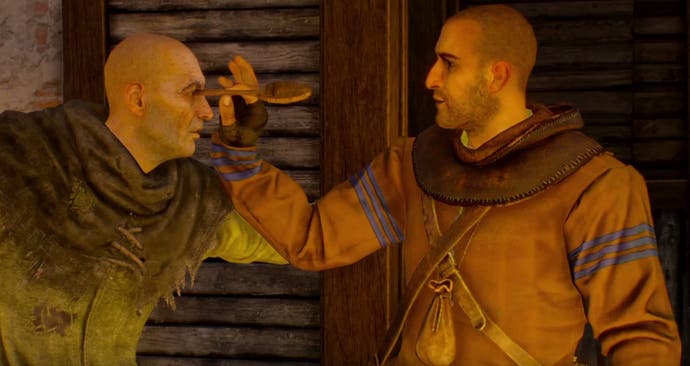
"He takes great pleasure in testing people - toying with them, looking to expose their hypocrisy and prove that appearances people are trying so desperately to keep are brittle facades that will crack under pressure. His end game - to show that there are no saints among humans and no rules a person will not break under the right circumstances."
So, other than reading up on German legend Faust - a tale of a man who makes a pact with the devil - where else do you look for inspiration to create a character like O'Dimm? For CD Projekt it was American TV show Breaking Bad, plucking traits from its fried chicken magnate and meth kingpin, Gustavo Fring. CD Projekt always outlines characters before writing dialogue, so a character's background and ideologies are on paper before they ever utter a word.
"When writing dialogues we add some nuance and flavor to the characters, but only things that are consistent with the core of that particular character," Stachyra says. "As the story and dialogues progress, so do the characters. When you meet someone for the first time, they don't fill you in on all their flaws and virtues, their first love, their childhood, or their fears immediately. Getting to know someone is a process. A process that regards both people and characters, because for us, characters are people - even if they're fictional."
That's why Breaking Bad's Gustavo Fring was a good fit - CD Projekt wanted to capture the calculating coldness of this otherwise ordinary-seeming man. It was a perfect fit for how the writers envisioned O'Dimm. There's something unsettling about a person who seems normal, yet they're capable of terrible things. We're hardwired to think the devil has horns.
There's a scene in Breaking Bad where Fring calmly puts on a boiler suit, walks close to one of his henchman and cuts his throat with a carpet knife. This scene was mirrored in one of O'Dimm's most memorable moments, when he first reveals his true powers to Geralt. You guessed it: it's the scene with the spoon. Towards the end of Geralt's contract, Master Mirror reveals the extent of his powers by freezing time when a man interrupts their conversation. As he leaves he casually pushes the handle of a wooden spoon deep into the man's eye - with a squelch - resuming time's flow so he can watch his body slump to the floor.
Stachyra explains why that Breaking Bad scene was such a key focus: "That moment had everything I was looking for: calmness, chills, determination, zero emotion, terror. So I took the feeling of that scene and created our version of it that fits our world, story and characters. The idea for a spoon to be the murder weapon of Gaunter's choice was that it was the last thing you'd think of someone to use as a murder weapon, which made the whole thing look all the more brutal and terrifying.
"When you see this scene - the trick with stopping time, O'Dimm's stone cold, brutal murder for daring to interrupt him, and finally, the realisation that this is one enemy even Geralt might not be able to defeat - you know that fun and games are over and the stakes have never been higher."
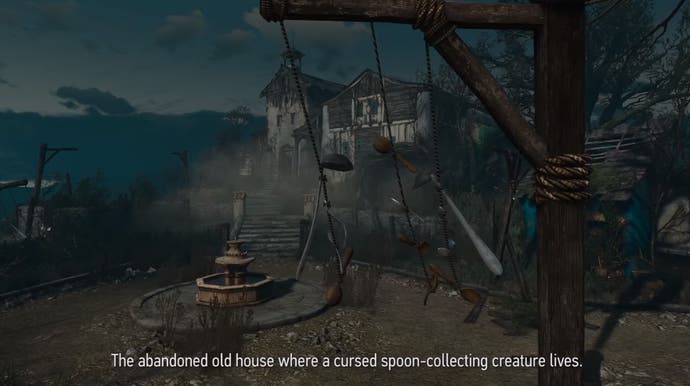
The use of a spoon led to it becoming a symbol of Master Mirror's influence, or a calling card. CD Projekt decided to include the object in the Olfieri prison ship earlier on. CD Projekt then used this symbol of power to remind players of his reach in the next expansion, Blood and Wine, where Geralt meets a cursed wight that's obsessed with collecting spoons. It's made pretty clear who placed this curse upon the unfortunate creature.
"It felt natural to have the Master Mirror's curse manifest itself in some way that involved spoons, especially if that curse regarded food," Stachyra explains. "Though Gaunter O'Dimm was not one of the main characters of [Blood and Wine's] story, we really wanted to show that his presence was not just limited to the encounters with Geralt and Olgierd von Everec.
"So, together with Paweł Sasko, the designer behind the wight spoon collector quest, we wanted to suggest that Master Mirror had a hand in Marlene's story. No one mentions his name, but the fact that it was indeed the Man of Glass who cursed Marlene is pretty clear from the story she tells Geralt. And when you add spoons to that, it becomes obvious that Gaunter O'Dimm continues to travel the world and test what we call 'human nature'."
Human nature seems to be quite the specialist subject at CD Projekt, which is why the studio manages to craft some of the most complex, interesting and memorable characters in video games - even if they're making one with binary morals like O'Dimm. The Polish studio doesn't craft characters by listing their traits or with a generic idea like a character archetype, they try and get to something relatable, something human - even the characters that aren't - and that's why CD Projekt's characters linger in the mind, even when they initially seem innocuous.
"We think about our characters as if they're people. We don't just throw a couple of random ideas out there and decide to go with a pattern" Stachyra tells me. "I want to believe that people are not just patterns, but that they're internally rich and complicated beings. That's the kinds of characters I want to create."
